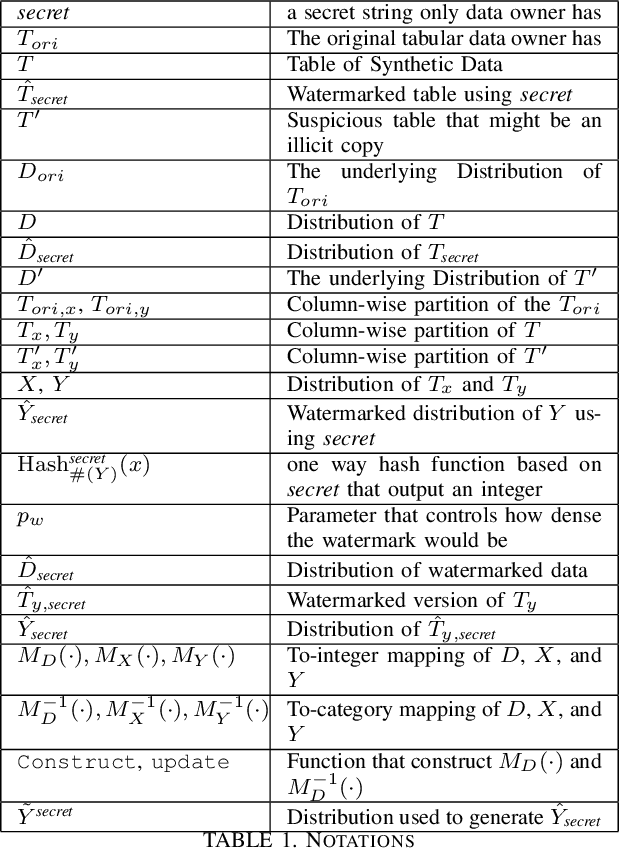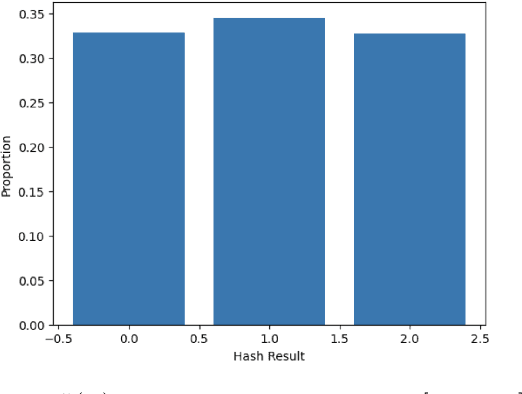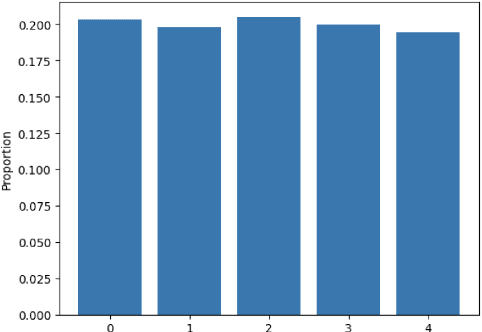Guang Cheng
Purdue
Discrete Guidance Matching: Exact Guidance for Discrete Flow Matching
Sep 26, 2025Abstract:Guidance provides a simple and effective framework for posterior sampling by steering the generation process towards the desired distribution. When modeling discrete data, existing approaches mostly focus on guidance with the first-order Taylor approximation to improve the sampling efficiency. However, such an approximation is inappropriate in discrete state spaces since the approximation error could be large. A novel guidance framework for discrete data is proposed to address this problem: We derive the exact transition rate for the desired distribution given a learned discrete flow matching model, leading to guidance that only requires a single forward pass in each sampling step, significantly improving efficiency. This unified novel framework is general enough, encompassing existing guidance methods as special cases, and it can also be seamlessly applied to the masked diffusion model. We demonstrate the effectiveness of our proposed guidance on energy-guided simulations and preference alignment on text-to-image generation and multimodal understanding tasks. The code is available through https://github.com/WanZhengyan/Discrete-Guidance-Matching/tree/main.
Error Analysis of Discrete Flow with Generator Matching
Sep 26, 2025Abstract:Discrete flow models offer a powerful framework for learning distributions over discrete state spaces and have demonstrated superior performance compared to the discrete diffusion model. However, their convergence properties and error analysis remain largely unexplored. In this work, we develop a unified framework grounded in stochastic calculus theory to systematically investigate the theoretical properties of discrete flow. Specifically, we derive the KL divergence of two path measures regarding two continuous-time Markov chains (CTMCs) with different transition rates by developing a novel Girsanov-type theorem, and provide a comprehensive analysis that encompasses the error arising from transition rate estimation and early stopping, where the first type of error has rarely been analyzed by existing works. Unlike discrete diffusion models, discrete flow incurs no truncation error caused by truncating the time horizon in the noising process. Building on generator matching and uniformization, we establish non-asymptotic error bounds for distribution estimation. Our results provide the first error analysis for discrete flow models.
Privacy Auditing Synthetic Data Release through Local Likelihood Attacks
Aug 28, 2025Abstract:Auditing the privacy leakage of synthetic data is an important but unresolved problem. Most existing privacy auditing frameworks for synthetic data rely on heuristics and unreasonable assumptions to attack the failure modes of generative models, exhibiting limited capability to describe and detect the privacy exposure of training data through synthetic data release. In this paper, we study designing Membership Inference Attacks (MIAs) that specifically exploit the observation that tabular generative models tend to significantly overfit to certain regions of the training distribution. Here, we propose Generative Likelihood Ratio Attack (Gen-LRA), a novel, computationally efficient No-Box MIA that, with no assumption of model knowledge or access, formulates its attack by evaluating the influence a test observation has in a surrogate model's estimation of a local likelihood ratio over the synthetic data. Assessed over a comprehensive benchmark spanning diverse datasets, model architectures, and attack parameters, we find that Gen-LRA consistently dominates other MIAs for generative models across multiple performance metrics. These results underscore Gen-LRA's effectiveness as a privacy auditing tool for the release of synthetic data, highlighting the significant privacy risks posed by generative model overfitting in real-world applications.
Risk In Context: Benchmarking Privacy Leakage of Foundation Models in Synthetic Tabular Data Generation
Jul 22, 2025Abstract:Synthetic tabular data is essential for machine learning workflows, especially for expanding small or imbalanced datasets and enabling privacy-preserving data sharing. However, state-of-the-art generative models (GANs, VAEs, diffusion models) rely on large datasets with thousands of examples. In low-data settings, often the primary motivation for synthetic data, these models can overfit, leak sensitive records, and require frequent retraining. Recent work uses large pre-trained transformers to generate rows via in-context learning (ICL), which needs only a few seed examples and no parameter updates, avoiding retraining. But ICL repeats seed rows verbatim, introducing a new privacy risk that has only been studied in text. The severity of this risk in tabular synthesis-where a single row may identify a person-remains unclear. We address this gap with the first benchmark of three foundation models (GPT-4o-mini, LLaMA 3.3 70B, TabPFN v2) against four baselines on 35 real-world tables from health, finance, and policy. We evaluate statistical fidelity, downstream utility, and membership inference leakage. Results show foundation models consistently have the highest privacy risk. LLaMA 3.3 70B reaches up to 54 percentage points higher true-positive rate at 1% FPR than the safest baseline. GPT-4o-mini and TabPFN are also highly vulnerable. We plot the privacy-utility frontier and show that CTGAN and GPT-4o-mini offer better tradeoffs. A factorial study finds that three zero-cost prompt tweaks-small batch size, low temperature, and using summary statistics-can reduce worst-case AUC by 14 points and rare-class leakage by up to 39 points while maintaining over 90% fidelity. Our benchmark offers a practical guide for safer low-data synthesis with foundation models.
From Static to Adaptive Defense: Federated Multi-Agent Deep Reinforcement Learning-Driven Moving Target Defense Against DoS Attacks in UAV Swarm Networks
Jun 09, 2025Abstract:The proliferation of unmanned aerial vehicle (UAV) swarms has enabled a wide range of mission-critical applications, but also exposes UAV networks to severe Denial-of-Service (DoS) threats due to their open wireless environment, dynamic topology, and resource constraints. Traditional static or centralized defense mechanisms are often inadequate for such dynamic and distributed scenarios. To address these challenges, we propose a novel federated multi-agent deep reinforcement learning (FMADRL)-driven moving target defense (MTD) framework for proactive and adaptive DoS mitigation in UAV swarm networks. Specifically, we design three lightweight and coordinated MTD mechanisms, including leader switching, route mutation, and frequency hopping, that leverage the inherent flexibility of UAV swarms to disrupt attacker efforts and enhance network resilience. The defense problem is formulated as a multi-agent partially observable Markov decision process (POMDP), capturing the distributed, resource-constrained, and uncertain nature of UAV swarms under attack. Each UAV is equipped with a local policy agent that autonomously selects MTD actions based on partial observations and local experiences. By employing a policy gradient-based FMADRL algorithm, UAVs collaboratively optimize their defense policies via reward-weighted aggregation, enabling distributed learning without sharing raw data and thus reducing communication overhead. Extensive simulations demonstrate that our approach significantly outperforms state-of-the-art baselines, achieving up to a 34.6% improvement in attack mitigation rate, a reduction in average recovery time of up to 94.6%, and decreases in energy consumption and defense cost by as much as 29.3% and 98.3%, respectively, while maintaining robust mission continuity under various DoS attack strategies.
A Probabilistic Perspective on Model Collapse
May 20, 2025Abstract:In recent years, model collapse has become a critical issue in language model training, making it essential to understand the underlying mechanisms driving this phenomenon. In this paper, we investigate recursive parametric model training from a probabilistic perspective, aiming to characterize the conditions under which model collapse occurs and, crucially, how it can be mitigated. We conceptualize the recursive training process as a random walk of the model estimate, highlighting how the sample size influences the step size and how the estimation procedure determines the direction and potential bias of the random walk. Under mild conditions, we rigorously show that progressively increasing the sample size at each training step is necessary to prevent model collapse. In particular, when the estimation is unbiased, the required growth rate follows a superlinear pattern. This rate needs to be accelerated even further in the presence of substantial estimation bias. Building on this probabilistic framework, we also investigate the probability that recursive training on synthetic data yields models that outperform those trained solely on real data. Moreover, we extend these results to general parametric model family in an asymptotic regime. Finally, we validate our theoretical results through extensive simulations and a real-world dataset.
GReaTER: Generate Realistic Tabular data after data Enhancement and Reduction
Mar 19, 2025Abstract:Tabular data synthesis involves not only multi-table synthesis but also generating multi-modal data (e.g., strings and categories), which enables diverse knowledge synthesis. However, separating numerical and categorical data has limited the effectiveness of tabular data generation. The GReaT (Generate Realistic Tabular Data) framework uses Large Language Models (LLMs) to encode entire rows, eliminating the need to partition data types. Despite this, the framework's performance is constrained by two issues: (1) tabular data entries lack sufficient semantic meaning, limiting LLM's ability to leverage pre-trained knowledge for in-context learning, and (2) complex multi-table datasets struggle to establish effective relationships for collaboration. To address these, we propose GReaTER (Generate Realistic Tabular Data after data Enhancement and Reduction), which includes: (1) a data semantic enhancement system that improves LLM's understanding of tabular data through mapping, enabling better in-context learning, and (2) a cross-table connecting method to establish efficient relationships across complex tables. Experimental results show that GReaTER outperforms the GReaT framework.
Golden Ratio Mixing of Real and Synthetic Data for Stabilizing Generative Model Training
Feb 25, 2025Abstract:Recent studies identified an intriguing phenomenon in recursive generative model training known as model collapse, where models trained on data generated by previous models exhibit severe performance degradation. Addressing this issue and developing more effective training strategies have become central challenges in generative model research. In this paper, we investigate this phenomenon theoretically within a novel framework, where generative models are iteratively trained on a combination of newly collected real data and synthetic data from the previous training step. To develop an optimal training strategy for integrating real and synthetic data, we evaluate the performance of a weighted training scheme in various scenarios, including Gaussian distribution estimation and linear regression. We theoretically characterize the impact of the mixing proportion and weighting scheme of synthetic data on the final model's performance. Our key finding is that, across different settings, the optimal weighting scheme under different proportions of synthetic data asymptotically follows a unified expression, revealing a fundamental trade-off between leveraging synthetic data and generative model performance. Notably, in some cases, the optimal weight assigned to real data corresponds precisely to the reciprocal of the golden ratio. Finally, we validate our theoretical results on extensive simulated datasets and a real tabular dataset.
Toward Intelligent and Secure Cloud: Large Language Model Empowered Proactive Defense
Dec 30, 2024Abstract:The rapid evolution of cloud computing technologies and the increasing number of cloud applications have provided a large number of benefits in daily lives. However, the diversity and complexity of different components pose a significant challenge to cloud security, especially when dealing with sophisticated and advanced cyberattacks. Recent advancements in generative foundation models (GFMs), particularly in the large language models (LLMs), offer promising solutions for security intelligence. By exploiting the powerful abilities in language understanding, data analysis, task inference, action planning, and code generation, we present LLM-PD, a novel proactive defense architecture that defeats various threats in a proactive manner. LLM-PD can efficiently make a decision through comprehensive data analysis and sequential reasoning, as well as dynamically creating and deploying actionable defense mechanisms on the target cloud. Furthermore, it can flexibly self-evolve based on experience learned from previous interactions and adapt to new attack scenarios without additional training. The experimental results demonstrate its remarkable ability in terms of defense effectiveness and efficiency, particularly highlighting an outstanding success rate when compared with other existing methods.
Watermarking Generative Categorical Data
Nov 16, 2024



Abstract:In this paper, we propose a novel statistical framework for watermarking generative categorical data. Our method systematically embeds pre-agreed secret signals by splitting the data distribution into two components and modifying one distribution based on a deterministic relationship with the other, ensuring the watermark is embedded at the distribution-level. To verify the watermark, we introduce an insertion inverse algorithm and detect its presence by measuring the total variation distance between the inverse-decoded data and the original distribution. Unlike previous categorical watermarking methods, which primarily focus on embedding watermarks into a given dataset, our approach operates at the distribution-level, allowing for verification from a statistical distributional perspective. This makes it particularly well-suited for the modern paradigm of synthetic data generation, where the underlying data distribution, rather than specific data points, is of primary importance. The effectiveness of our method is demonstrated through both theoretical analysis and empirical validation.
 Add to Chrome
Add to Chrome Add to Firefox
Add to Firefox Add to Edge
Add to Edge